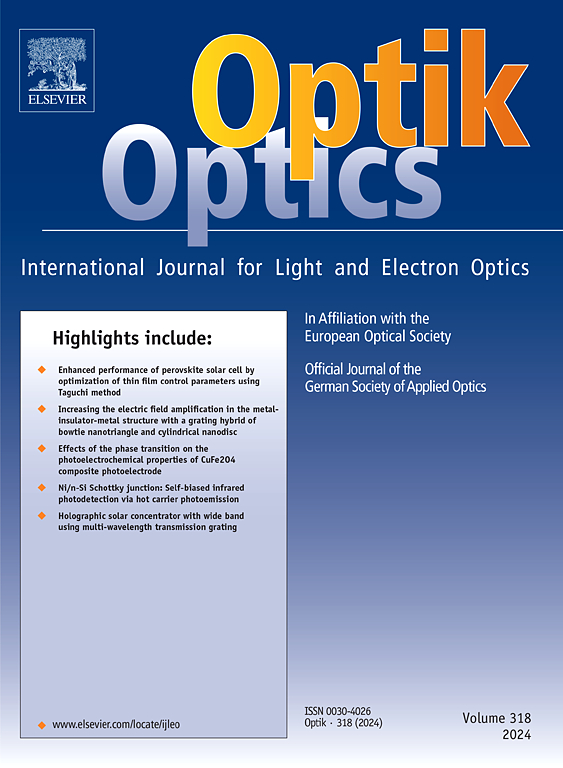利用nilotica叶片提取物环保合成nb掺杂Fe2O3纳米颗粒的光催化和抗菌应用
IF 3.1
3区 物理与天体物理
Q2 Engineering
引用次数: 0
摘要
本研究以金合欢叶提取物为稳定剂,合成了Fe₂O₃纳米颗粒(NPs)。然后通过水热法制备了浓度为5 %、10 %和15 %的铌。这项工作的目的是评估掺杂浓度对光催化性能的影响,特别是对甲基橙(MO)和亚甲基蓝(MB)的降解,以及对两种革兰氏阴性菌(P.反硝化菌,P.嗜麦芽菌)和两种革兰氏阳性菌(P.链球菌,B.枯草杆菌)的抗菌活性。通过各种表征技术研究了未掺杂和nb掺杂的Fe₂O₃NPs的结构和功能特性。其中包括傅立叶变换红外光谱(FTIR)用于振动和旋转性质,x射线衍射(XRD)用于结构分析,动态光散射(DLS)用于粒度分布,zeta电位用于表面电荷,以及紫外可见光谱用于光学性质。PL光谱显示,在1.76 eV左右发生带边发射。SEM和EDX显示了NPs的形态和元素组成。扫描电镜显示为六边形。在阳光下的光催化研究表明,15 % nb掺杂的Fe₂O₃-NPs具有最高的降解效率,在150和180 min内分别实现了70 %的亚甲基蓝(MB)和55 %的甲基橙(MO)的降解。在未掺杂的样品中,5 % nb掺杂的Fe₂O₃-NPs表现出最有效的抗菌活性,特别是对反硝化副球菌(P. denitrificans)。本文章由计算机程序翻译,如有差异,请以英文原文为准。
Eco-friendly synthesis of Nb-doped Fe2O3 nanoparticles using Acacia nilotica leaf extract for photocatalytic and antibacterial applications
In this study, Fe₂O₃ nanoparticles (NPs) were synthesized using Acacia nilotica (kiker) leaf extract, which acted as a stabilizing agent. The nanoparticles were then doped with niobium at concentrations of 5 %, 10 %, and 15 % through hydrothermal process. The goal of the work was to evaluate the effect of doping concentrations on both photocatalytic performance, specifically in the degradation of methyl orange (MO) and methylene blue (MB), and antibacterial activity against two Gram-negative bacteria (P. denitrificans, P. maltophilia) and two Gram-positive bacteria (P. streptococcus, B. subtilis). The structural and functional properties of the undoped and Nb-doped Fe₂O₃ NPs were examined through various characterization techniques. These included Fourier Transform Infrared Spectroscopy (FTIR) for vibrational and rotational properties, X-ray Diffraction (XRD) for structural analysis, Dynamic Light Scattering (DLS) for particle size distribution, zeta potential for surface charge, and UV–visible spectroscopy for optical properties. PL spectroscopy showed that the band edge emission occurred at around 1.76 eV. SEM and EDX showed the morphology and element composition of the NPs. SEM showed the hexagonal shapes. Photocatalytic studies under sunlight revealed that the 15 % Nb-doped Fe₂O₃-NPs exhibited the highest degradation efficiency, achieving 70 % methylene blue (MB) and 55 % methyl orange (MO) degradation in 150 and 180 minutes, respectively. Among the undoped samples, the 5 % Nb-doped Fe₂O₃-NPs displayed the most potent antibacterial activity, particularly against Paracoccus denitrificans (P. denitrificans).
求助全文
通过发布文献求助,成功后即可免费获取论文全文。
去求助
来源期刊

Optik
物理-光学
CiteScore
6.90
自引率
12.90%
发文量
1471
审稿时长
46 days
期刊介绍:
Optik publishes articles on all subjects related to light and electron optics and offers a survey on the state of research and technical development within the following fields:
Optics:
-Optics design, geometrical and beam optics, wave optics-
Optical and micro-optical components, diffractive optics, devices and systems-
Photoelectric and optoelectronic devices-
Optical properties of materials, nonlinear optics, wave propagation and transmission in homogeneous and inhomogeneous materials-
Information optics, image formation and processing, holographic techniques, microscopes and spectrometer techniques, and image analysis-
Optical testing and measuring techniques-
Optical communication and computing-
Physiological optics-
As well as other related topics.
 求助内容:
求助内容: 应助结果提醒方式:
应助结果提醒方式:


